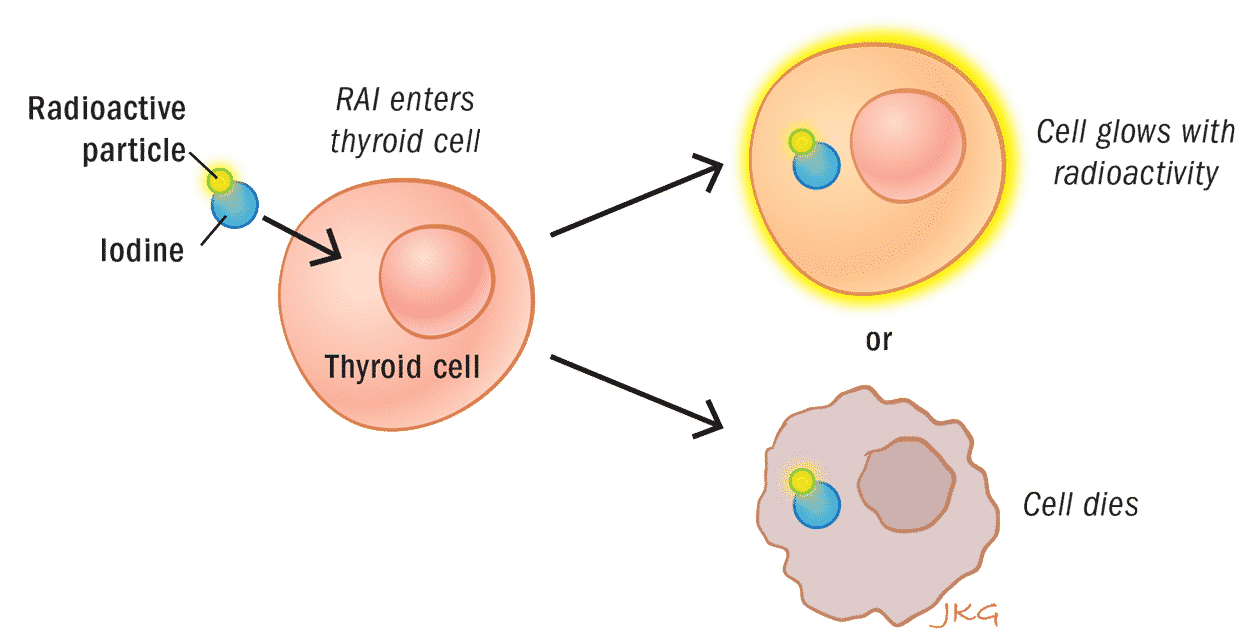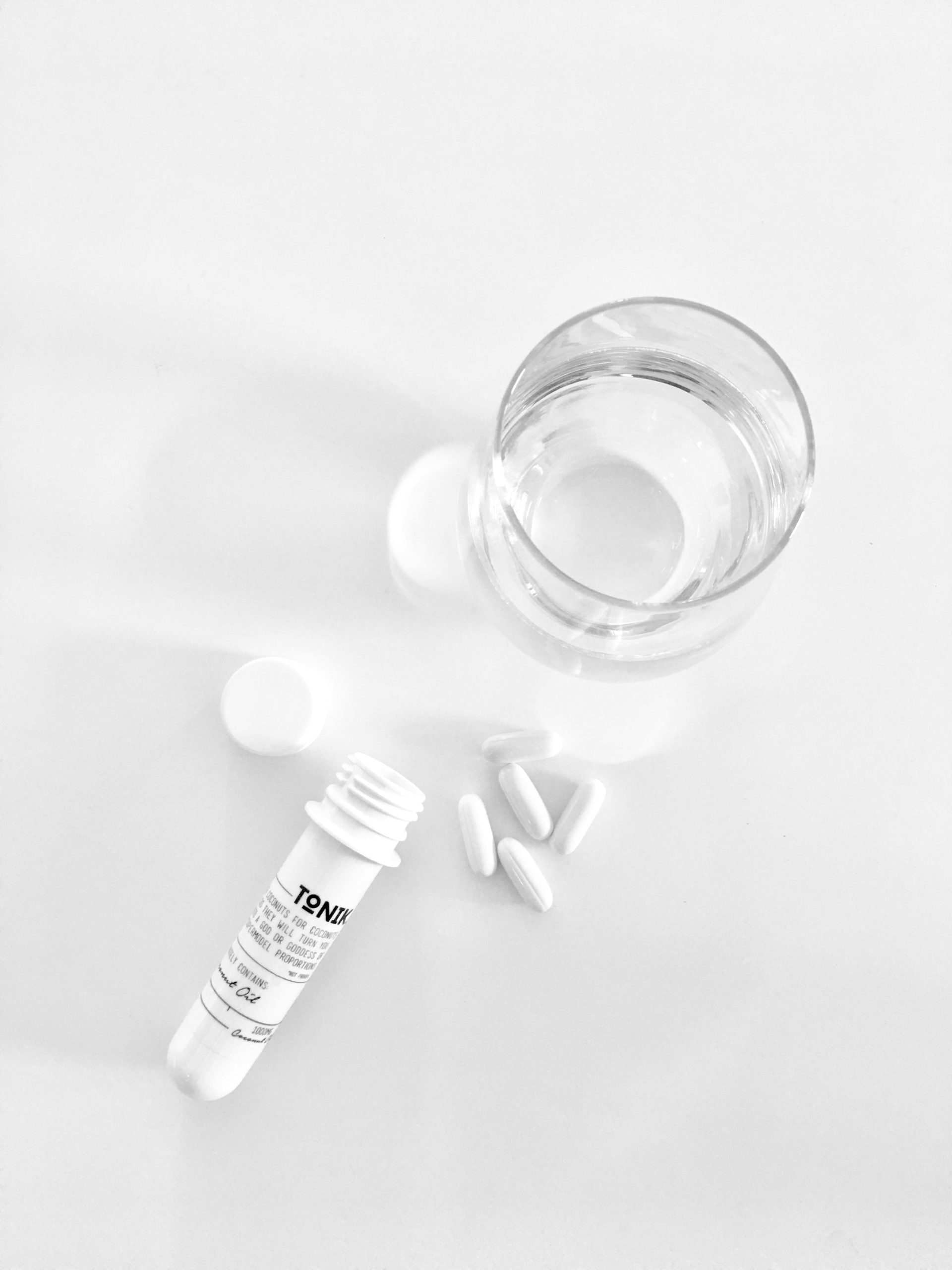Radioactive Iodine (RAI) Therapy
While surgery remains the first step in the treatment of differentiated thyroid cancer, radioactive iodine ablation therapy, also known as RAI, may be useful as an additional treatment, or as therapy for other thyroid diseases. The thyroid gland is made up of a special type of cell that absorbs iodine circulating in the body and uses it to produce thyroid hormones. Even cancerous thyroid cells retain this ability. RAI therapy takes advantage of this quality of thyroid cells.
In this treatment, radioactive Iodine (iodine molecules that emit radiation) is administered orally, and is then absorbed by any thyroid tissue that exists throughout the body, both healthy and cancerous. Once inside the thyroid cells (whether they exist in the neck or in distant metastases throughout the body), the radioactive iodine (Iodine-131) will kill the cells by releasing beta particles.
This radioactive iodine will affect all thyroid cells, no matter where in the body they are located, but will not damage normal tissue. These features make radioactive iodine a good treatment for thyroid cancer, because the Iodine-131 will damage the cancerous cells and prevent the cancer from growing, without affecting other cells in the body.

Of note, RAI is generally not used in patients who received a hemithyroidectomy, as the treatment would destroy the remaining thyroid lobe.
RAI is also only used in patients whose thyroid cancer cells absorb iodine. Some types of cancer (Medullary Thyroid Cancer, Anaplastic Thyroid Cancer, and Lymphoma) do not take up iodine, and therefore cannot be treated with RAI. Additionally there are some cases of well-differentiated thyroid cancers that, over time, lose their cell’s ability to concentrate iodine, and therefore treatment with RAI is no longer effective.
Indications for Treatment
The decision to use RAI after a total thyroidectomy in patients with differentiated thyroid cancer is based on the risk of recurrence given to each specific case. This risk of recurrence is determined based on tumor-specific characteristics, involvement of lymph nodes, and distant sites of disease, among others.
The American Thyroid Association (ATA) guidelines suggest when to use RAI according to the risk of recurrence.
Low Risk
Patients that are considered to have a low risk of recurrence generally do not receive RAI treatment. Many of these patients are treated surgically with a hemithyroidectomy, so RAI is not recommended. The use of RAI in low risk patients is debatable, and no clear consensus exists. In selected cases, such as patients with intrathyroidal tumors greater than 4 cm, specific characteristics or pathologic findings may call for low-dose RAI therapy. Doctors will discuss the benefits and possible side effects of RAI treatment, and patient preference will be considered.
Intermediate Risk
Patients considered to have an intermediate risk of recurrence will generally undergo a total thyroidectomy, followed by RAI.
High Risk
Patients considered to have a high risk of recurrence will be treated with a total thyroidectomy, followed by RAI therapy.
Read detailed definitions of low, intermediate and high risk papillary thyroid cancers.
Low risk
Patients are considered to be low risk if their tumor is found to have the following characteristics:
No local or distant metastases All macroscopic tumor has been resected No invasion of locoregional tissues (cervical lymph nodes , strap muscles, etc…) Tumor was not found to have an aggressive histologic variant* No vascular invasion No 131I uptake outside the thyroid bed on the post treatment scan (if done) Either no clinical evidence of spread to the lymph nodes OR fewer than 5 pathologic N1 micrometastases (<0.2 cm in largest dimension)
Patients that are considered to have a low risk of recurrence generally do not undergo RAI treatment.
Intermediate Risk
Patients are considered to be intermediate risk of recurrence if their tumor is found to have the following characteristics:
Microscopic invasion into the perithyroidal soft tissues Cervical lymph node metastases or 131I avid metastatic foci in the neck on the post-treatment scan done after thyroid remnant ablation Tumor with aggressive histology* or vascular invasion Clinical N1 lymph nodes OR greater than 5 pathologic N1 lymph nodes with all involved lymph nodes < 3 cm in largest dimension Multifocal papillary thyroid microcarcinoma with extrathyroidal extension and BRAF V600E mutation (if known)
These patients will generally undergo a total thyroidectomy, followed by RAI.
High Risk
Patients are considered to be at high risk of recurrence if their tumor is found to have the following characteristics.
Macroscopic tumor invasion Incomplete tumor resection with gross residual disease Distant metastases Postoperative serum thyroglobulin suggestive of distant metastases Pathologic N1 lymph nodes with any metastatic lymph node >3 cm in the largest dimension Follicular thyroid cancer with extensive vascular invasion ( >4 foci of vascular invasion)
These patients will be treated with a total thyroidectomy, followed by RAI therapy.
* Aggressive histologic variants
| Tall cell variant of papillary thyroid carcinoma |
| Insular variant of papillary thyroid carcinoma |
| Columnar cell variant of papillary thyroid carcinoma |
| Hürthle cell carcinoma |
| Follicular thyroid carcinoma |
| Hobnail variant of papillary thyroid carcinoma |
Preparing for Treatment
Before starting RAI treatment, it is important to consider several factors that might change the effectiveness of treatment. There are several factors that might impact the ability of any remaining thyroid tissue to absorb radioiodine and respond to treatment.
- TSH (Thyroid Stimulating Hormone) levels.
- Iodine exposure through a person’s diet or with medication (such as Amiodarone).
- Iodine Contrast enhanced CT scans.
Levels of a hormone called TSH (Thyroid Stimulating Hormone) can impact radioactive iodine uptake by thyroid tissue. Therefore it is important for doctors to evaluate a patient’s TSH values with a thyroid function panel before prescribing RAI.
In order to ensure that thyroid cells absorb enough of the radioactive iodine, the patient will need to undergo hormone stimulation. This will involve increasing the patient’s blood levels of Thyroid Stimulating Hormone (TSH). TSH is a hormone that stimulates the growth of thyroid tissue and signals the thyroid gland to absorb more iodine and produce more thyroid hormone. It is important that TSH levels are high when radioiodine is used because TSH stimulates the thyroid to accumulate iodine.
TSH levels can be increased in two different ways. One method is to reduce the levels of thyroid hormone in the blood by having the patient stop taking their thyroid hormone for several weeks. This absence will lead to an increase in the release of TSH into the bloodstream. The second option is to inject recombinant human TSH (a synthetic form of thyroid stimulating hormone) to artificially increase TSH levels.
The Importance of Diet & Medication
Other known factors that might impact the uptake and effectiveness of RAI therapy include iodine exposure from food, medication, and the contrast media used for imaging studies. Before undergoing RAI, the patient will be asked to consume a low-iodine diet. In order for the treatment to be successful, the thyroid tissue must absorb the radioactive iodine instead of normal iodine. The low-iodine diet reduces the amount of normal iodine in the body, thereby avoiding competition for absorption between the regular iodine from food and the administered radioactive iodine.
Patients recently exposed to iodine through medication have been proven to have a lower uptake of radioactive iodine, which can lower the effectiveness of RAI treatment. Doctors should know their patients’ complete medical history, including a list of used medications, in order to guarantee improved outcomes.
Dosing
The dose of I131 used for ablation therapy should be discussed with the team of treating physicians (Surgeon, ENT specialist and Endocrinologist). The dose of RAI should be tailored to each patient and scenario. There is no standard “one size fits all” dose of RAI that is used across all patients with thyroid cancer. Rather, the administered dose is personalized and should be carefully chosen based on intraoperative findings, risk of recurrence, information from additional tests, and the patients’ wishes.
The Intended Use of RAI Therapy
What is the purpose of RAI treatment? This is an important question to consider when choosing the dose of radioactive iodine. RAI therapy can be used with different intentions.
- To ablate residual normal thyroid tissue where complete removal of the thyroid gland was not possible.
- As adjuvant therapy to “attack” any possible remaining cancerous tissue in patients with intermediate to high-risk of recurrence.
In general lower doses are used in patients with low-risk of recurrence (based on ATA classification), as compared to patients with intermediate or high-risk of recurrence.
Special Considerations
RAI can never be administered who are pregnant or actively breastfeeding. Radiation is extremely harmful to the developing fetus. RAI should only be administered if a woman has had a negative pregnancy test within 72 hours prior to treatment.
RAI & Pregnancy
If thyroid cancer is diagnosed during pregnancy, it is usually safe to wait until after delivery to perform any treatments (including surgery and RAI). However, it is advised that patients diagnosed with thyroid cancer during pregnancy be under close follow-up with their doctors to monitor for disease progression.
If the diagnosis of thyroid cancer is known prior to pregnancy, patients are advised to plan future pregnancies carefully to avoid possible maternal and fetal complications that could result from both the disease and treatment. Generally, couples should wait until after the cancer has been surgically removed and RAI treatment has been completed, if applicable.
It is important to emphasize that not all patients will require RAI treatment. If RAI is indicated, pregnancy should be delayed for at least 6 months after the completion of therapy. This waiting period will help ensure complete elimination of all radioactive material from the body. Furthermore, it will give doctors time to perform a comprehensive workup and decide if any further treatment will be necessary.
Breastfeeding
If a patient is breastfeeding and is determined to require RAI therapy, the patient should stop breastfeeding prior to treatment. During breastfeeding, the mammary glands develop the ability to concentrate iodine. If a patient were to inject radioactive iodine while breastfeeding, the breast tissue would uptake the radioactive iodine, which would put the newborn at risk of ingesting the radioactive iodine.
Additionally, by increasing the uptake of iodine in breast tissue, breastfeeding decreases the iodine amount of iodine that is absorbed by thyroid tissue, thereby making RAI treatment less effective. It is recommended that patients stop breastfeeding at least six to eight weeks before RAI therapy to help reduce the uptake of radioiodine by breast tissue.
After the completion of RAI therapy, it is possible to measure the radioactivity of breast milk. Once the levels are determined to be safe for the newborn, breastfeeding can be resumed.
Complications
Although RAI treatment has been established as a safe and reliable treatment, it is not free of adverse side effects. The most common side effects are related to the additional tissues outside of the thyroid that have the capability of absorbing iodine (salivary glands, breasts, bladder, and gastrointestinal tract).
For example, the salivary glands will absorb some of the administered radioactive iodine, and will be damaged as a result. Patients treated with RAI therefore may experience a reduction in salivary flow, or the amount of saliva that they produce).
Common Symptoms of Salivary Gland Dysfunction
- Decreased or altered sense of taste.
- Dental cavities and tooth loss.
- Painful swelling of the salivary glands.
- Secondary malignancies.
To help with these symptoms, patients should make sure to stay well-hydrated to help increase urine output and elimination of the Iodine-131. Additionally, the use of lemon candies or other substances that increase the production of saliva may be helpful. Recent research studies have mentioned that a technique called parotid massage may help improve the function of the parotid glands.
Secondary Malignancies
Secondary malignancies have been reported after RAI therapy for thyroid cancer. The development of other tumors or cancers associated with RAI therapy is most common in sites that have the capability of absorbing iodine, such as the salivary glands, breasts, bladder, and gastrointestinal tract. The risk of developing non-solid cancers such as leukemia is also increased. Current research has suggested that the risk of secondary malignancies increases with higher doses of RAI.













